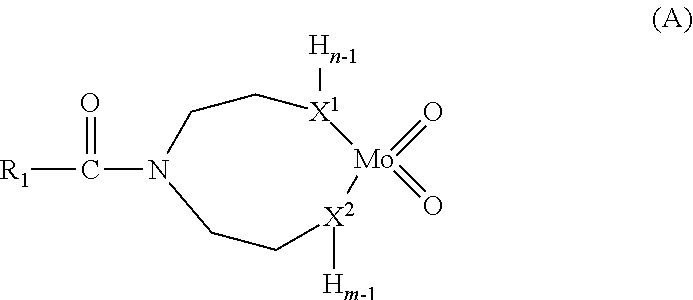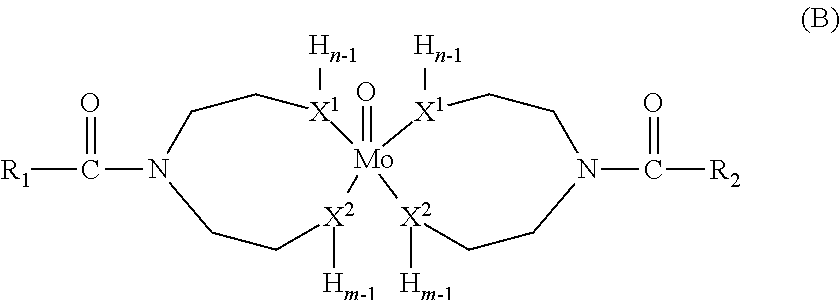Lubricating compositions for preventing or reducing pre-ignition in an engine
a technology of lubricating compositions and engine, applied in the direction of lubricant compositions, additives, petroleum industry, etc., can solve the problems of significant negative impact on engine efficiency and overall performance, pre-ignition phenomenon, sharp increase in temperatures and pressures, etc., to prevent or reduce pre-ignition, prevent or reduce low-speed pre-ignition
- Summary
- Abstract
- Description
- Claims
- Application Information
AI Technical Summary
Benefits of technology
Problems solved by technology
Method used
Image
Examples
example 1 preparation
of Lubricating Compositions According to the Invention
[0206]The various components of the lubricating compositions according to the invention CI1 and CI2 are mixed according to the nature and the quantities presented in Table 1.
TABLE 1CI1CI2Gr III base oil85.0184.77Viscosity Index Improver5.005.00(Polyisobutene StyreneHydrogenated or PISH)Anti-wear (DTPZn)0.630.80Antioxidant amine0.800.80(Diphenylamine)Detergent (Calcium sulphonate)2.002.00Dispersant (Bis-Succinimide)6.006.00Mo-DTP (Sakuralube 300)0.56Sulfur-Free Molybdenum0.63Complex (Molyvan 855)KV 100 (measured in mm2 / s8.38.3according to ASTM D445)
example 2
on of Comparative Lubricating Compositions
[0207]The various components of the comparative lubricating composition CC1 are mixed according to the nature and amounts shown in Table 2
TABLE 2CC1Gr III base oil84.90Viscosity Index Improver5.00(Polyisobutene StyreneHydrogenated or PISH)Anti-wear (DTPZn)0.80Antioxidant amine0.80(Diphenylamine)Detergent (Calcium sulphonate)2.00Dispersant (Bis-succinimide)6.00Mo-DTC (Sakuralube 525)0.50KV 100 (measured in mm2 / s8.3according to ASTM D445)
example 3
Evaluation of the Pre-Ignition Reduction Properties of the Lubricating Compositions According to the Invention CI1 and CI2 and of the Comparative Lubricating Composition CC1
[0208]This evaluation is performed by evaluating the impact of each lubricating composition on the low-speed pre-ignition (LSPI).
[0209]For this, the LSPI phenomenon is quantified by means of a GM Ecotech model spark ignition turbocharged engine composed of 4 cylinders in line for a total displacement of 2.0 L.
[0210]After a heating period of 20 minutes at an engine speed of 2000 rpm and an engine load of 4.105 Pascal effective average pressure (EAP), the test procedure consists of 2 sequences under heavy load (23.105 Pascal EAP at a speed of 2.000 rpm), 2 sequences under low load (13.105 Pascal of EAP at a speed of 1.250 rpm) and 2 sequences under heavy load identical to the first 2. Each sequence comprises 25.000 motor cycles to ensure a good statistical representativeness of the phenomenon studied.
[0211]Each cyl...
PUM
| Property | Measurement | Unit |
|---|---|---|
| weight | aaaaa | aaaaa |
| viscosity index | aaaaa | aaaaa |
| speed | aaaaa | aaaaa |
Abstract
Description
Claims
Application Information
 Login to View More
Login to View More - R&D
- Intellectual Property
- Life Sciences
- Materials
- Tech Scout
- Unparalleled Data Quality
- Higher Quality Content
- 60% Fewer Hallucinations
Browse by: Latest US Patents, China's latest patents, Technical Efficacy Thesaurus, Application Domain, Technology Topic, Popular Technical Reports.
© 2025 PatSnap. All rights reserved.Legal|Privacy policy|Modern Slavery Act Transparency Statement|Sitemap|About US| Contact US: help@patsnap.com



